#New Orleans voodoo
Text
On September 10th we venerate Elevated Ancestor, Voodoo Queen of Louisiana, & Saint, Marie Catherine Laveau on her 222nd birthday 🎉
[for our Hoodoos of the Vodou Pantheon]

Marie Catherine Laveau was a dedicated Hoodoo, healer, herbalist, & midwife who, "traveled the streets [of New Orleans] like she owned them", as the most infamous Voodoo Queen of New Orleans.
Marie C. Laveau I was born a "Free Mulatto" in today's French Quarter in what was then, New France); to a mother & grandmother who were both born into slavery & later freed via freedom papers. It is believed that she grew up in the St. Ann Street cottage of her maternal grandmother.
She married Jacques Santiago-Paris, a "Quadroon" "Free Man of Color", who fled as a refugee from Saint-Domingue, Haiti from the Haitian Revolution in the former French colony . After his passing, she became known as "The Widow Paris". She then worked as a hairdresser catering to White families & later entered a domestic partnership with a French nobleman his death. She excelled at obtaining inside information on her wealthy patrons by instilling fear in their servants whom she either paid or cured of mysterious ailments. Although she never abandoned her Catholic roots, she became increasingly interested in her mother’s African traditional beliefs. The Widow Paris learned her craft from a ‘Voodoo doctor’ known variously as Doctor John or John Bayou.
Marie C. Laveau I is said to have intiated into Voodoo career sometime in the 1820s. She's believed to be descended from a long line of Voodoo Priestesses, all bearing her same name. She was also a lifelong devout Catholic. It didn’t take long before Marie C. Laveau I dominated New Orleans Voodoo culture & society before claiming title of Queen. She was the 3rd Voodoo Queen of NOLA - after Queen Sanité Dédé & Queen Marie Salopé. During her decades tenure, she was the premier beacon of hope and service to customers seeking private consultations - to aid in matters such as family disputes, health, finances, etc, created/sold gris gris, perforemed exorcisms. While her daughter Marie II was known for her more theatrical displays of public events, Marie C. Laveau I was less flamboyant in her persona. She conducted her work in 3 primary locations throughout the city: her home on St. Ann Street, Congo Square, & at Lake Pontchartrain. Despite one account of a challenge to her authority in 1850, Marie C. Laveau I maintained her leadership & influence.
The Queen died peacefully in her sleep in her ole cottage home on St. Ann Street. Her funeral was conducted according to the rite of the Catholic Church & in the absence of any Voodoo rites. To her Voodoo followers, she's venerated as a Folk Saint. In² addition to her Priesthood in Voodoo and title of Queen, she is also remembered for her community activism; visiting prisoners, providing lessons to women of the community, & doing ritual work for those in need.
She is generally believed to have been buried in plot 347, the Glapion family crypt in Saint Louis Cemetery No. 1, New Orleans. As of March 1st, 2015, there is no longer public access to St. Louis Cemetery No. 1. Entry with a tour guide is required due to continued vandalism & tomb raiding.
We pour libations & give her💐 today as we celebrate her for her love for & service to the people, through poverty, misfortune, bondage, & beyond.
Offering suggestions: flowers + libations at her grave, catholic hymns, holy water, gold rings/bracelets, money
‼️Note: offering suggestions are just that & strictly for veneration purposes only. Never attempt to conjure up any spirit or entity without proper divination/Mediumship counsel.‼️
#hoodoo#hoodoos#atr#atrs#the hoodoo calendar#conjure#rootwork#rootworkers#ancestor veneration#Marie c Laveau#Voodoo#Voodoo Queens#new orleans#new orleans Voodoo#Vodou Pantheon#Haitian Voodou
419 notes
·
View notes
Photo

A manbo (also written as mambo) is a priestess (as opposed to a oungan, a male priest) in the Haitian Vodou religion. Haitian Vodou's conceptions of priesthood stem from the religious traditions of enslaved people from Dahomey, in what is today Benin. For instance, the term manbo derives from the Fon word nanbo ("mother of magic"). Like their West African counterparts, Haitian manbos are female leaders in Vodou temples who perform healing work and guide others during complex rituals.
This form of female leadership is prevalent in urban centers such as Port-au-Prince (the capital of Haiti). Typically, there is no hierarchy among manbos and oungans. These priestesses and priests serve as the heads of autonomous religious groups and exert their authority over the devotees or spiritual servants in their hounfo (temples).
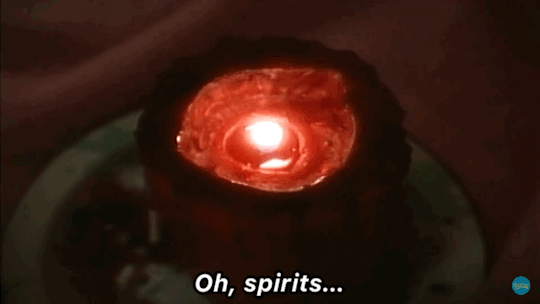
Manbos and oungans are called into power via spirit possession or the revelations in a dream. They become qualified after completing several initiation rituals and technical training exercises where they learn the Vodou spirits by their names, attributes, and symbols.
The first step in initiation is lave tèt (head washing), which is aimed at the spirits housed in an individual's head. The second step is known as kouche (to lie down), which is when the initiate enters a period of seclusion. Typically, the final step is the possession of the ason (sacred rattle), which enables the manbos or oungans to begin their work. One of the main goals of Vodou initiation ceremonies is to strengthen the manbo's konesans (knowledge), which determines priestly power.
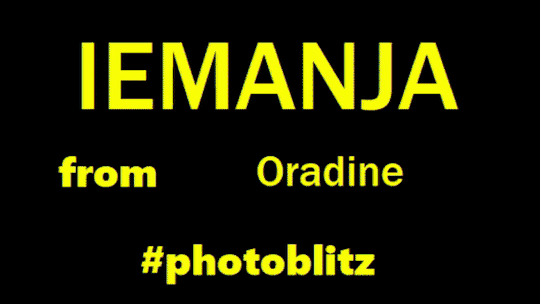
The specific skills and knowledge gained by manbos enable them to mediate between the physical and spiritual realms. They use this information to call upon the spirits through song, dance, prayer, offerings, and/or the drawing of vèvès (spiritual symbols). During these rituals, manbos may either be possessed by a loa (also spelled lwa, Vodou spirits) themselves, or may oversee the possession of other devotees. Spirit possession plays an important role in Vodou because it establishes a connection between human beings and the Vodou deities or spirits. Although loas can "mount" whomever they choose, those outside the Vodou priesthood do not have the skills to communicate directly with the spirits or gods. This is because the human body is merely flesh, which the spirits can borrow to reveal themselves via possession. manbos, however, can speak to and hear from the Vodou spirits. As a result, they can interpret the advice or warnings sent by a spirit to specific individuals or communities.

Cécile Fatiman is a Haitian manbo famously known for sacrificing a black pig in the August 1791 Vodou ceremony at Bois Caïman—an act that is said to have ignited the Haitian Revolution. There are also notable manbos within the United States. Marie Laveau (1801-1888), for example, gained fame in New Orleans, Louisiana, for her personal charm and Louisiana Voodoo practices.
Renowned as Louisiana's "voodoo queen", Laveau's legacy is kept alive in American popular culture (e.g., the television series America Horror Story: Coven).ne Mama Lola is another prominent manbo and Vodou spiritual leader in the United States. She rose to fame after the publication of Karen McCarthy Brown's ethnographic account Mama Lola: A Vodou Priestess in Brooklyn. Mama Lola's success provided her with a platform to challenge Western misconceptions of Haitian Vodou and make television appearances

#kemetic dreams#vodun#cecile fatiman#manbo#bois caiman#manbos#haitian#marie laveau#new orleans#new orleans voodoo#mama lola#vodou#lwa#oungan#nando#fan#west african#west african vodun#mother of magic#joey bada$$#brooklyn
281 notes
·
View notes
Text
Some Old School New Orleans Voodoo Pics I Wanted To Share.

Top one can be found online it's of New Orleans voodoo ritual with Mama Moona, Priestess Ava Jones & Voodoo Queen Priestess Rose Frank.(1975)

This above pic is of New Orleans voodoo Priest Joshua Frank. The Voodoo King at the time.
Joshua Frank was the Voodoo King of New Orleans and was a well-known and respected tour guide at The Voodoo Museum. He was a old man who like singing in French and then there's his daughter Priestess Rose. Who's in the photo up top. This was a man I remember at the voodoo museum who gave tours and worked for the late Charles Gandolfo who own the museum they help me with learning some voodoo and even pointed me in the right direction in learning.
21 notes
·
View notes
Text
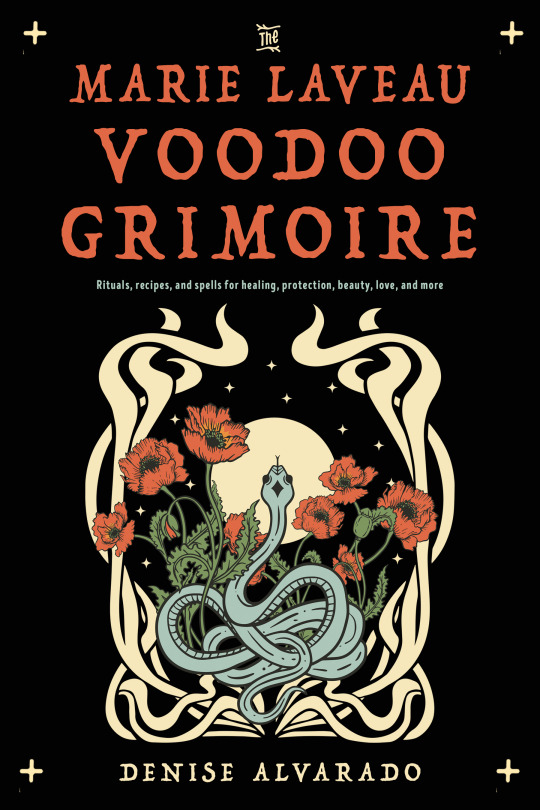
Marie Laveau was one of the wisest women that ever lived.
She was gifted with a power from on high that very few people are gifted with. She could look at you without ever having seen you before and tell you where you were born, what hour you were born and the time, and also the condition of the weather if you wanted to know that. She was, in a way, to me another Solomon, sent from the Almighty God above to come down here and help his people. I also picture her as a John De Baptist who comes to teach right and righteousness. This woman that I am telling you about prayed not three times a day as Daniel did but prayed every hour in the day that our Heavenly Father sent. I picture her as one chosen by God’s own hand. She was not selfish, but waited on the Black as well as the White, and the rich as well as the poor. Doing all the good stuff she could. And never doing any harm to anybody.
~Old Man George Nelson, 1936
Marie Laveau possesses an enduring magick as the preeminent witch queen, Voodoo Queen, and heavenly Saint in New Orleans. Her style of Voodoo encapsulates all the mystery, glamour, and power every witch, folk magic practitioner, and Vodouisant longs for. And let’s face it, witches love pretty things - shiny black mirrors and crystals and stones, beautiful tarot cards, and gold embossed velvet bags in which to keep them. We love the smell of incense, flowers, and perfumes as much as the aroma of a healing chicken soup on the kitchen stove. Living a tradition that is, in its very essence, natural, harmonious, and exquisitely beautiful, we see the allure in what others may deem profane. In The Marie Laveau Voodoo Grimoire, I continue where The Magic of Marie Laveau left off. This book is a working grimoire geared towards the modern witch and conjure worker that provides spells, advice, formulas, and recipes for solving the problems of daily living and enhancing quality of life in the most magickal of ways.
Available direct from the author here: The Marie Laveau Voodoo Grimoire (creolemoon.com)
If you would like a signed copy, just make a request upon checkout and I will be happy to sign a copy for you.
#hoodoo#conjure#rootwork#creolemoon#neworleansvoodoo#witchcraft#marielaveau#authordenisealvarado#new orleans voodoo
43 notes
·
View notes
Text





Representation of Haitian Voodoo in comics. Integrating its rich mythology and its deities.
Art by: vodou.renaissance
#witches#witchcraft#witch#baby witch#witch community#witches of tumblr#pop magick#pop culture magic#louisiana hoodoo#hoodoo witch#new orleans hoodoo#hoodoo#creole voodoo#new orleans voodoo#louisiana voodoo#voodoo#folk magic#folklore#african folk magick#pop culture witchcraft#pop culture witch#pop culture magick#pop culture#comic#comics#comic art
12 notes
·
View notes
Text
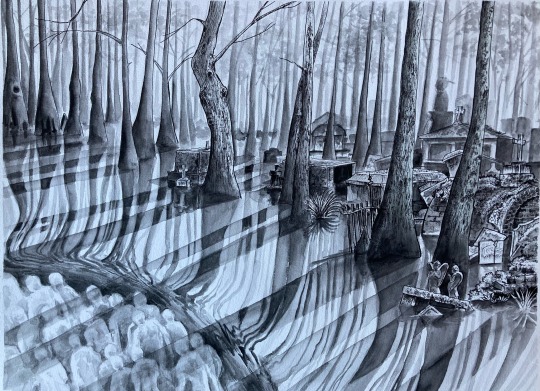


Bon Fête Gede!
#art#traditional art#new orleans voodoo#day of the dead#artist of tumblr#illustration#fetegede#honey island swamp#swamp gothic#drawing#art on tumblr#artists on tumblr#fantasy#nature#folktale#watercolor#painting#bayou
4 notes
·
View notes
Text
Emily and Laika are thankfully two separate beings, two separate vessels
#hoodoo#voodoo#brujeria#witchcraft#dark magic#black magic#sorcery#Haitian voodoo#creole voodoo#new orleans voodoo#all sorts of witchcraft and voodoo#stone Magic
0 notes
Text



Maman Brigitte gris gris altar doll handmade by me. She is the loa of
Life, Death, Justice, Motherhood, Fertility, Cemeteries, Crosses, Gravestones, Women, Souls of Deceased Relatives, and abused women.
The doll is about 13 inches tall,my hand is in the photo so you get a idea of scale.
Please be aware that voodoo dolls are repository’s for spirits.
I’m Cajun from southern Louisiana so I have been raised around voodoo and gris gris. They are made with herbs,charms and stones inside them. Please make note they have a scent due to the herbs and oils I use when making them. Due to the handmade nature of the dolls each will be a little different. They are also dressed with oils from @haus_ov_phaedra .The way to use the doll is either to talk to it or tie your petition on a piece of paper to it. Dolls come with instructions.
It’s 45.00
Which is with shipping within the USA.
If you want it dm me your PayPal email and I’ll send you a invoice.Sorry no holds!Payment is expected immediately.
#uglyshyla#voodoo#Louisiana voodoo#Cajun#grisgris#loa#goddess#goddess of death#Voodoodoll#hoodoo#new Orleans voodoo#goddess of women#the Baron
1 note
·
View note
Text
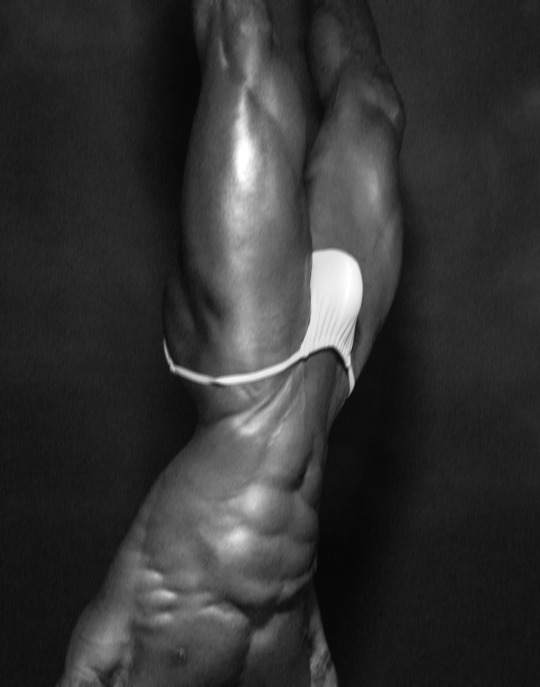
Voodoo- Hamidou Banor by Baldovino Barani for FACTORY Fanzine XXXVI
#rufskin#as above so below#posing straps#hamidou banor#hamidiu banor#baldovino barani#factory fanzine#voodoo#vaudou#muscle#beauty#new orleans#french quarter#magik#divination#baron samedi
2K notes
·
View notes
Photo

I tried to answer this succinctly, but it turned into an essay. (Sorry.)
The Princess and the Frog was not accurate, strictly speaking, but dinging it for that would be like criticizing the Lion King for not being a realistic wildlife documentary. Accuracy wasn't really the point. Given the fantastical elements and fictional nations like “Maldonia”, I suppose we're meant to understand this as a bit removed from the real New Orleans. It's more a a jazz-flavored fairy tale than a historical fiction.
But for discussion's sake....
Is it fashion-accurate to its 1926 timeframe? Ehhh, sort of. It pays homage to 20s fashion trends with cloche hats, furs and feathery headpieces, but without fully committing to it. The waistline on almost all of Tiana's clothing is too high for the 20s, and the the shapes of her fancier costumes take a lot of liberties, or deviate wildly from the style of the period.
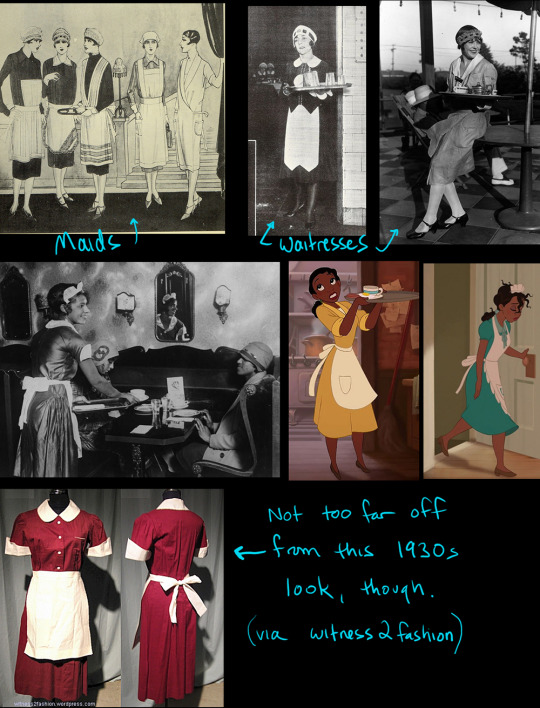
In the 20s, dresses (including workaday stuff) tended to have a straight up-and-down shape to it - kind of a low-waisted rectangle that de-emphasized curves instead of highlighting them. There are valid reasons to play fast and loose with that, though (something I’m definitely guilty of as well). One of those reasons is communication.
For instance, speculatively, the filmmakers wrote Tiana as a hard-working waitress and wanted her to look the part, so they made the choice to clothe her in something familiar - that gingham dress of mid-century shape that we broadly associate with diner waitresses. Actual waitress uniforms of the 20s had a fair bit of overlap with maid uniforms at the time too, and I can see why they wouldn't want to risk the confusion. It's more important to communicate clearly with the larger audience than to appease a small faction of fashion nerds who'd notice or care about the precision.
I don't think it's a case of the designers failing to do their research - I'm sure they had piles of references, and maybe even consultants - but they also had to have priorities.
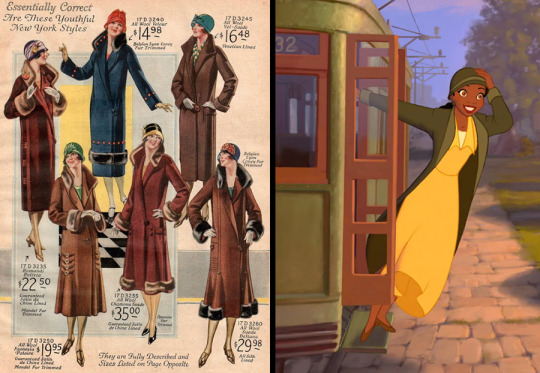
With her hat and coat on, she looks a lot more 1920s-shaped.
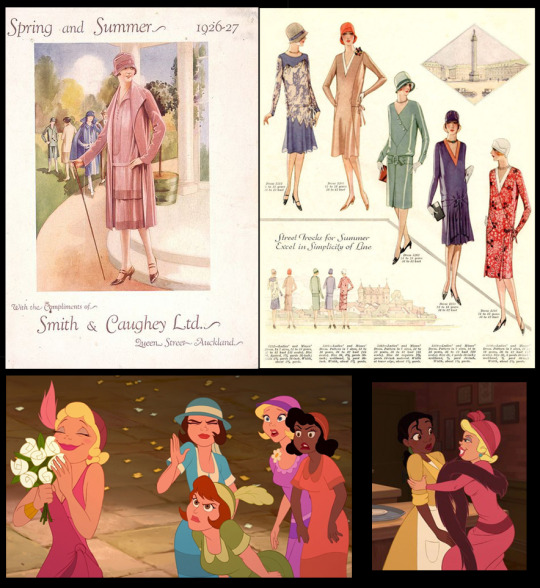
Pretty consistently, the indication of the characteristic 1920s drop waist is there, but the approach otherwise ignores the 20s silhouette. The clothes hug the body too much. This may be about appealing to a 2000s audience, visually speaking, but also could be an animation thing. Maybe both. For practical reasons, clothes in 2d animation are usually more a sort of second skin than something that wears or behaves like realistic fabric.

These are not in the 1920s ballpark at all. Tiana's blue gown looks like your basic Disney brand invention. Strapless things would have been extremely unusual and the overall shape is far out of step. Excusable, I guess, because it's a costume in context. Charlotte looks like she’s heading for a mimosa brunch in a modern maxi dress.
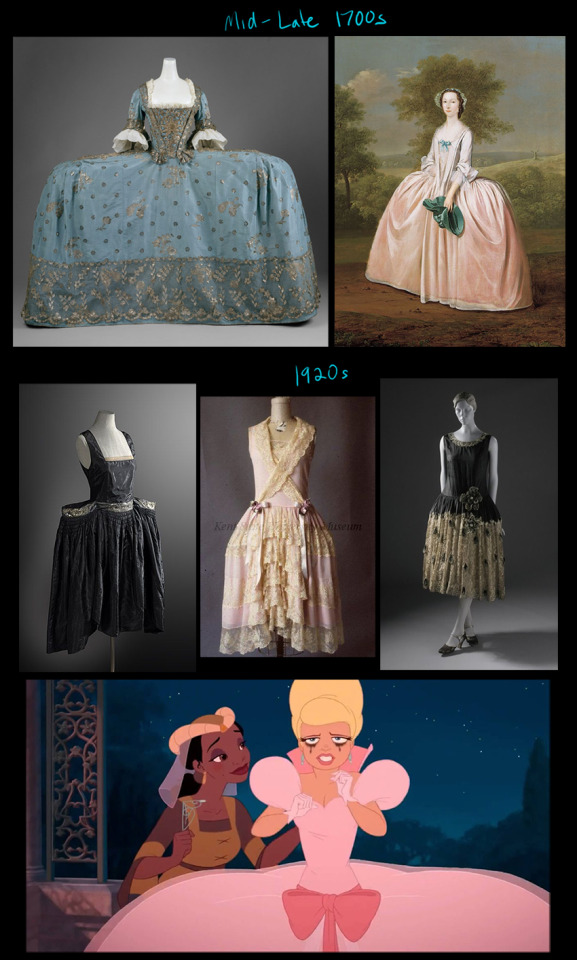
Charlotte's princess dress did seem to be calling back to the ultra-wide pannier side hoops of the 18th century - something that made a reappearance for part of the 20s, albeit in much milder form called robe de style. I'm not sure if the filmmakers were alluding to that at all, really, but either way, her dress is hilarious.
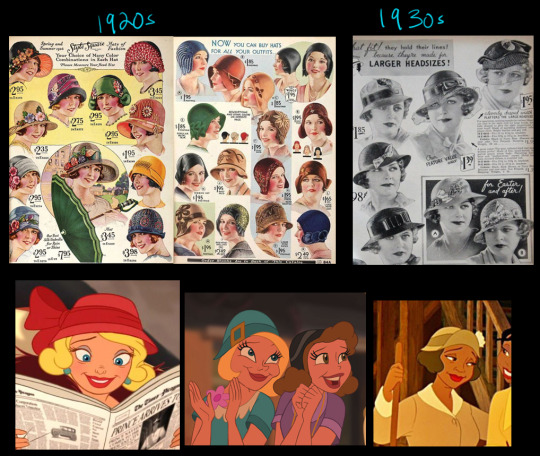
They only went about halfway with the cloche hats. The 1920s cloche really encapsulated the cranium, almost entirely covered bobbed hair, and obscured much of the face from certain angles, so it's easy to see why they've been somewhat reined in for the film. Still, it ends up looking more 1930s, where the hats started to recede away from the face, evolving in the direction of the pillbox.
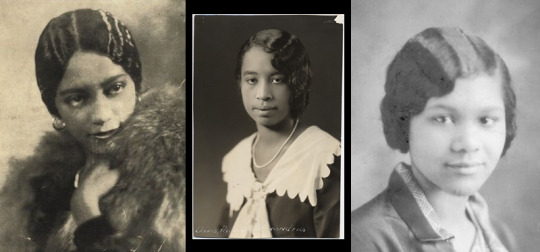
Similarly, Tiana's hair is not very reminiscent of the bobbed, close-to-the-cranium style of the period, but I think that could legitimately be written off as characterization. She's not at all the type of person who'd fuss about going à la mode. Not everyone bobbed and finger-waved their hair.

The clothes Prince Naveen is introduced in are very 1920s collegiate in spirit - the wide-leg oxford bags, the sleeveless pullover sweater, the flat cap, and high, stiff collar. The ukulele and banjolele were pretty trendy instruments at the time too.
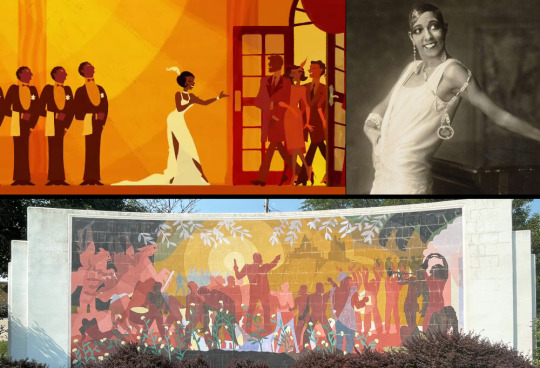
Definitely some Josephine Baker vibes here. Also, the look of this whole fantasy sequence was reportedly inspired by the works of Aaron Douglas, a luminary painter of the Harlem Renaissance known for his depictions of the lives of African-Americans. (The mural is in Topeka, Kansas.)
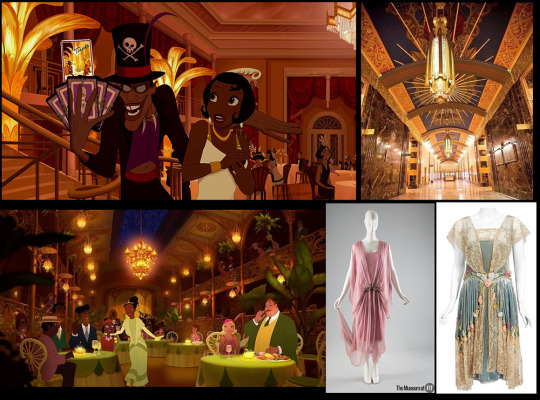
They pretty much nailed the Art Deco. It's gorgeous. Looks somewhat inspired by the interiors of some of the Ralph Walker-designed NYC architecture, plus some French Quarter balcony flair for the final manifestation of Tiana's Place. Her dress here does resemble some gauzy mid-1920s looks, too.
------------------------------------------------
Culturally speaking...
New Orleans is an unusual place. Because some of the colonial Spanish and French laws and conventions that New Orleans evolved under persisted even after its inception into the United States; because it was such a heterogeneous hub of indigenous and immigrant peoples; and because it had a considerable population of free people of color (mostly Creole), it did not function quite like the rest of the South leading up to the Civil War, nor for a while after. Its particular coalescence of cultures made it its own unique sort of culture within the country, within the region, within the state of Louisiana even. By the early 20th century, though, regardless of the not-very-binary nature of New Orleans, Jim Crow laws were enforcing a literal black-and-white distinction, and not an evenhanded one, by far. In that aspect, the city had begun to resemble the rest of the South.
The film nods at the wealth disparity, but goes on to paint a pretty rosy picture of race and class relations at the time. Still it's not unbelievable that some people were exceptions to the rules. You could probably find a few compartments of old New Orleans society that resisted segregation or certain prejudicial norms, preferring to do things their own way. That aside, the film wasn't trying to confront these topics. Not every piece of media should have to. Sometimes breaking away from miserable period piece stereotypes is refreshing. I'm not sure it could have handled that meaningfully given the running time, narrow story focus, and intended audience, anyhow. (But you could perhaps also make a case that family films habitually underestimate younger audiences in this way.)
------------------------------------------------
Raymond the firefly I guess is the film's Cajun representation. There's not much to say about it, except perhaps to note that Evangeline is a reference to the heroine of a Longfellow poem of the same name. The poem is an epic romance set during the expulsion of the Acadians from the eastern provinces of Canada and the northernmost reaches of the American colonies (now Maine) by the British in the mid-1700s. Many exiled Acadians gradually migrated south to francophone-friendly Louisiana, settling into the prairies and bayous, where 'Acadian' truncated into the pronunciation 'Cajun'. Evangeline - who is only finally reunited with her love when he’s on his deathbed - has become an emblem of the heartbreak, separation and faithful hope of that cultural history, and there are parishes, statues and other landmarks named after the her throughout Louisiana.
------------------------------------------------
Voodoo does have a very historical presence in New Orleans, having arrived both directly from West Africa and by way of the Haitian diaspora (where it would more properly be called Vodou). While I don't think Disney's treatment of it was especially sensitive or serious, it also wasn't the grotesquely off-base sort of thing that media of the past has been known to do. It was largely whittled down to a magical plot component, but it wasn't so fully repurposed that it didn't resemble Voodoo at all either - and that's mostly owing to the characters, because it does appear the writers pulled from history there.
It’s apparently widely held that Dr. Facilier is a Baron Samedi caricature - and likely that's true, in part - but I have the impression he's also influenced by Doctor John. Not the 20th century funk musician, but the antebellum “Voodoo King” of New Orleans. Doctor John (also called Bayou John, Jean La Ficelle, and other aliases) claimed to be a Senegalese prince. He became well known as a potion man and romance-focused prognosticator to people from all corners of society. Though highly celebrated and financially successful at his peak, he seems ultimately remembered as an exploitative villain.
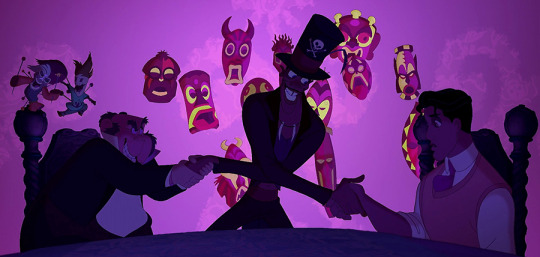
To my recollection, the film sort of gingerly avoids referring to Facilier as a Voodoo practitioner directly (I think he's more generically called a witch doctor in the script?) but it does seem to imply his 'friends on the other side' are a consortium of loa. It's mostly abbreviated into nebulously evil-seeming special FX, glazing over any specificity or dimensionality, but it does also loop back around as a vehicle of moral justice. Loa are all very individualistic and multi-faceted, but they do have reciprocal rules for asking favors of them.
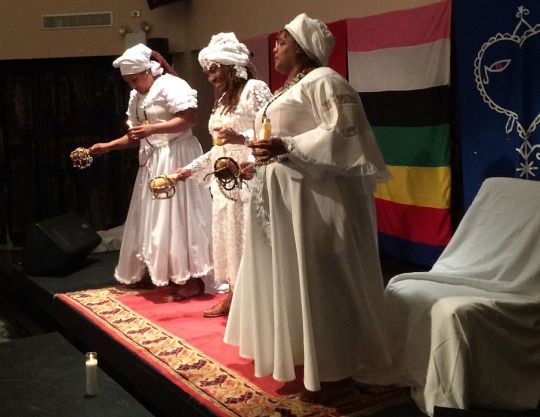
There's also the benevolent counterpart in Mama Odie's character. Her wearing ritual whites has a definite basis in Voodoo/Vodou practice, and her depiction as a fairy godmother-like figure isn't entirely out of step with how a mambo may have been perceived...in a very general sense. They were/are ceremonial leaders and community bastions who people would seek out for help, advice and spiritual guidance. More than just emanating matronly good vibes, though, some have wielded considerable political and economic power.
(Just my opinions here. I've done a lot of reading on the subject for research but I'm no authority with any special insider understanding of Voodoo, and I really shouldn't be relied upon as an arbiter of who has or hasn't done it justice in fiction.)
------------------------------------------------
In summary--
Culturally, I think the film is respectably informed but paints a superficially genteel picture. The set pieces are gorgeous, but the story mostly delivers a sort of veneer of New Orleanishness. And as for fashion, well, it’s the 1920s run through a Disney filter. It’s very pretty, but it’s only as proximally accurate as seemed practical.
I don’t know that any of that really matters so much as whether or not it achieved what it intended, though. As a charming yarn and as a tribute to New Orleans and the Jazz age, I think it’s mostly successful. It’s also really beautifully animated!
#princess and the frog#disney#1920s#new orleans#jazz#fashion#voodoo#vodou#history#animation#art deco
5K notes
·
View notes
Text
On December 1st we venerate Elevated Ancestor & Voodoo Priest Frank Staten aka Prince Ke’eyama on the 25th anniversary of his passing 🕊 [for our Hoodoos of the Vodou Pantheon by way of New Orleans & Haiti]
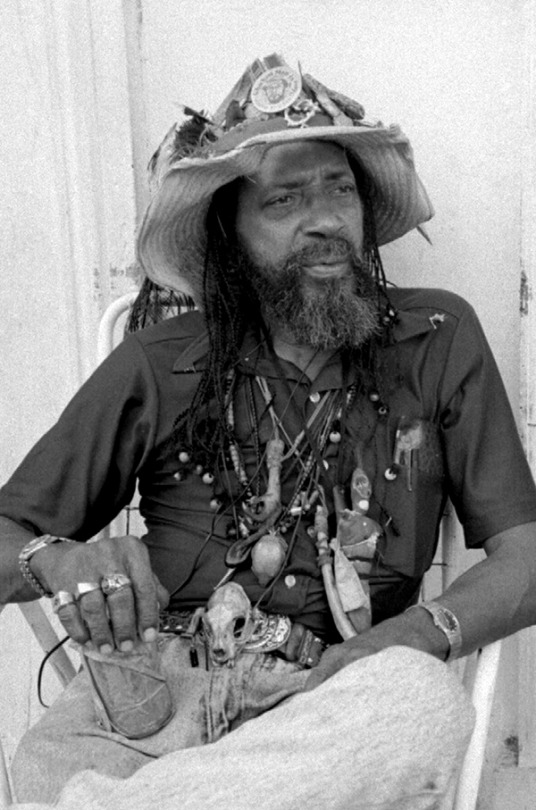
Prince Ke’eyama was a Healer, Rootworker, & intuitive reader - recognized as the King of New Orleans Voodoo by many for his ;the locals knew him simply as, “The Chicken Man".
Born Frank Staten of Haitian descent, his family relocated from Haiti to New Orleans when he was an infant in the late '30s. Though raised Baptist under the ministry of his grandfather, it was his grandmother who initiated him into Rootwork & introduced him to Haitian Voodoo. Through his grandmother he learned to work the roots & the Lwa in order to help others.
At the age of 9, a revelation changed the course of his life forever. It was then that his grandfather revealed to him that he was blessed with magick & was a Healer. This was amplified by his grandmother's revelation that he was born of royal descent; to a lineage of powerful kings of the past whose legacy was his mantle to carry for the rest of his life. From this moment forward he was given a new name: Prince Ke’eyama.
Under the firm guidance of his grandparents, Ke’eyama developed into a powerful worker. Once his most peel animal spirit totem was revealed to him during meditation & prayer, he began following a strict diet of including chicken in his every meal. Doing so was said to enable him to swallow glass & consume fire unharmed. He'd go on to travel across the States to other Voodoo communities & frequent his roots in Haiti. He was an unmistakable figure in his appearance; locs decorated with feathers & ribbons, his signature straw hat, a long staff, & a big smile. Thus, his reputation & strength blossomed.
It wasn't until the early 70s that Prince Ke’eyama returned to New Orleans & witnessed the tumultuous nature & chaos of rampant drug abuse that swept the city. He was determined to make this is ground zero to answer his life calling of being a Healer. To attract the people, he fell back on an old nightclub act that he'd perform during his adventures on the road. He'd amaze his audiences with his mastery of Voodoo, revealing the power of God. Thus, "The Chicken Man" was born. His shows included: tribal dancing, simple magick, & fire-eating then was climaxed by eating a live chicken raw; he'd bite the head off & drink it’s blood, fixing it's neck into a makeshift straw. Though this reviled many, just as many others perceived this act less about entertainment & more of a sacrifice on the part of Prince Ke’eyama on behalf of everyone present. Those who did began to seek him out for counseling & aid in healing. By making a spectacle of himself,
Prince Ke’eyama was able to fulfill his work as a Healer. His shows, counseling, conducting readings, & selling gris-gris etc was his ministry. The streets of New Orleans - particularly the French Quarter - were his congregation. Most people encountered him on the street as The Chicken Man by him intuitively reading them at a distance. By the time he zeroed in on someone, he had already had their prescription in mind. Unlike many priests or workers, he pursued his patients.
He developed a tremendous following in the 70s-80s. Many locals saught him out for his services. And was recognized as a powerful priest by those of the local Voodoo Community practicing what they proclaimed to be “true” Voodoo – most prominently Lady Bianca. Still, many popular vodusi dismissed him as sheer entertainment. This ostricization spurred The Cult of the Chicken Man; secret group of dedicated followers. This became one of the largest secret societies in the city since the time of Voodoo Queen Madame Marie Laveau.
Upon his death in 1998, Prince Ke’eyama's ashes were donated to the Voodoo Spiritual Temple in New Orleans where they remain enshrined by Sister Miriam Chamani.
We pour libations & give 💐 today as we celebrate him for his dedicated healing work, imparting the wisdom of his & the collective of ancestral elders through his teachings, & for being a symbolic lesson of what it means to be a product of self-determination in the wake of Maafa.
Offering suggestions: raw or cooked chicken, Baptist prayers/scripture, bourbon, snake charms
‼️Note: offering suggestions are just that & strictly for veneration purposes only. Never attempt to conjure up any spirit or entity without proper divination/Mediumship counsel.‼️
#hoodoo#atr#hoodoos#the hoodoo calendar#atrs#ancestor veneration#rootwork#rootworkers#Haiti#Ayiti#Prince keeyama#Frank Staten#NEw Orleans#Voodoo#Haitian Vodou#New orleans Voodoo
53 notes
·
View notes
Photo
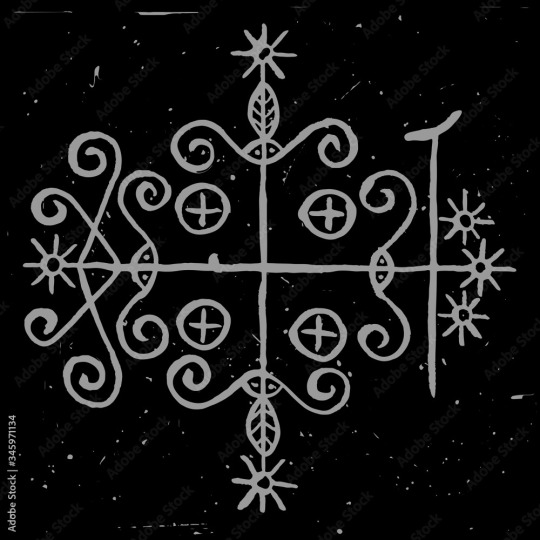

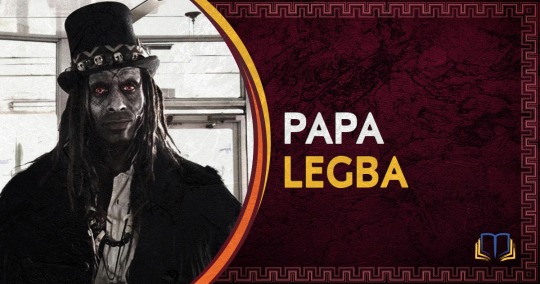
Does the Witch Doctor in Africa countries make Kabbalistic Pacts with the Devil like in Haitian Voodoo and Jamaican Obeah?
They most certainly do not make Kabbalistic Pacts with the Devil which is a Judeo Christian Islamic concept, which they were not, African priest and priestess doubled as healers both spiritual and physical , they understand there is a duality in nature as in the spiritual worlds one can tap into , eg Horus cannot exist without his polar opposite Set.
Now that said there are areas where both the Christian concepts became entwined with African religious concepts as in the cross roads and Papa Legba.
Because slave owners were worried about potential rebellion, they often separated enslaved people from the same area.
By mixing people from different regions and language groups, they could use the communication barrier to discourage or even prevent revolt. However, many of the deities were similar, and so enslaved people from different parts of Africa soon found commonalities in their spiritual beliefs and practices, which they were forced to keep hidden.
Papa Legba soon found a home in the religious structures of enslaved people in Haiti and the Caribbean, as well as in the American colonies. Author Denise Alvarado says Legba:
...stands at a spiritual crossroads and grants or denies permission to speak with the spirits of Guinee, and is believed to speak all human languages. He is always the first, and the last spirit invoked in any ceremony because his permission is needed for any communication between mortals and the loa—he opens and closes the doorway to the spirit world.
Over time, after African syncretic practices blended with Catholicism in the new world, Legba became associated with several saints, including Saint Peter, Saint Anthony, and Saint Lazarus.
In the Haitian religion of Vodou, Legba is seen as the intermediary between mortal men and the loa, or lwa. The loa are a group of spirits responsible for various aspects of daily life, and they are the children of a supreme creator, Bondye. They are divided into families, such as the Ghede and Ogou, and practitioners develop relationships with them through offerings, petitions, and prayers. Often, Papa Legba is the one who carries these prayers to the loa.
Note the cross roads would later become associated with the devil in this religious synchronism.
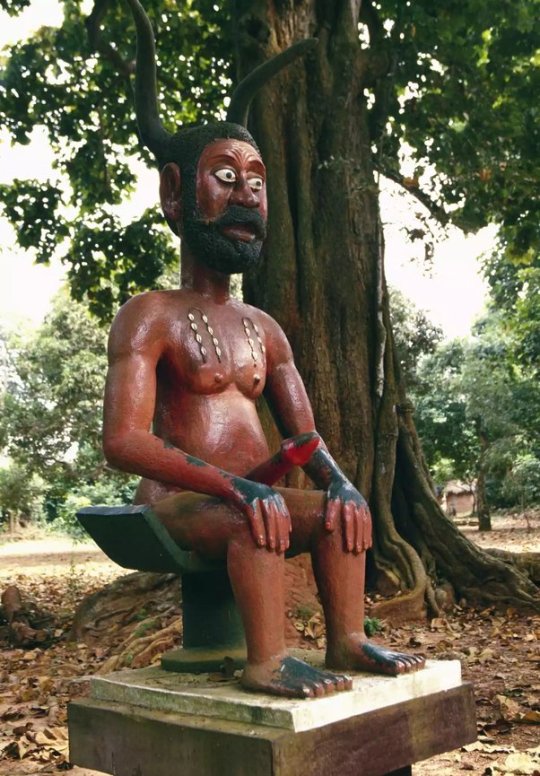
Statue of Legba as fertility god. Atlantide Phototravel / Getty Images Plus
Legba has evolved in numerous ways from his origins in Africa, where he is sometimes viewed as a fertility god or a trickster; he many be depicted as both male and female, sometimes with a large erect phallus. In other areas, he is a protector of children or a healer, and can grant forgiveness for crimes against others. Variants of Legba exist in many places including Brazil, Trinidad, and Cuba.
Papa Legba appears in many forms in New Orleans Voodoo and Haitian Vodou. He is typically depicted as an older man, sometimes wearing a straw hat or old tattered clothing, walking with a cane, and accompanied by a dog. He's associated with the colors black and red.
Legba is strongly associated with crossroads magic, and is referenced in a number of early twentieth-century blues tunes from the area of the Mississippi Delta. Famed bluesman Robert Johnson is said to have met a spirit at the crossroads, and offered him his soul in exchange for musical success. Although eventually the story was twisted to say Johnson met the Devil, musical folklorists believe that tale is rooted in racist ideology; instead, Johnson met Legba at the crossroads, where he had gone seeking guidance and wisdom.
Papa Legba is a master communicator, who is said to speak the languages of all human beings; he then translates petitions and delivers them to the loa. He is a teacher and warrior, but also a trickster deity. Legba is a remover of obstacles, and can be consulted to help find new, positive opportunities, thanks to his ability to open doors and new roads
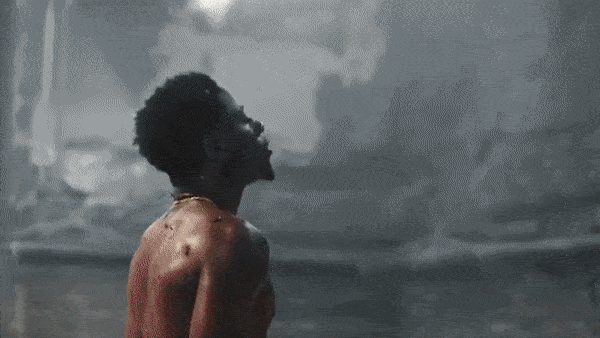
Legba represents a West African and Caribbean Voodoo god. This god has many different names depending on the region in which he is worshipped is most commonly known in Haiti as Papa Legba. Papa Legba serves as the guardian of the Poto Mitan--the center of power and support in the home. Additionally, he allows for communication between humans and the spirit world. According to West African Voodoo practices, spirits of the dead are not able to inhabit one's body unless permitted by Papa Legba. The symbol for Legba typically has a red background, one of his representative colors. The symbol includes several keys which signify Legba's control over communications and forms of passage, including locks, gates, and passageways;it also includes a cane, as Papa Legba is generally depicted as an old and feeble man in the Haitian religion. There are many chants to summon Papa Legba, one of which is: Papa Legba, Open the gate for me/Atibon Legba, Open the gate for me/Open the gate for me/Papa that I may pass/When I return I will thank the Lwa.

GYE NYAME - Supremacy of God
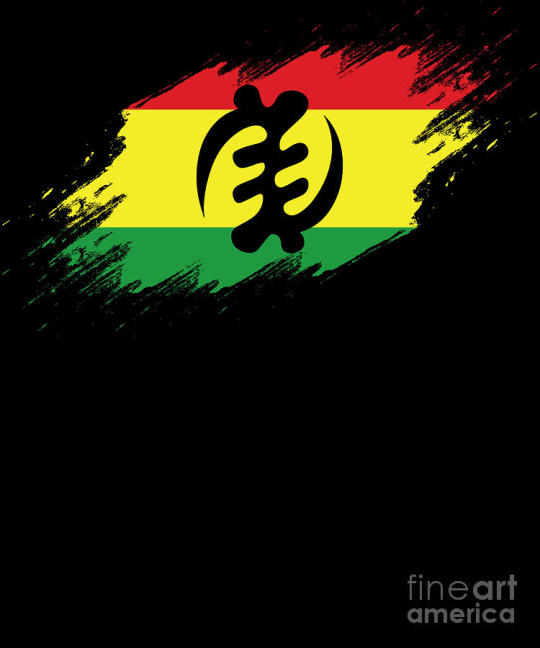
Gye Nyame, meaning “except for God,” symbolizes God’s omnipotence through the knowledge that people should not fear anything except for God. Another interpretation of “except for God” is that no one has seen the beginning of all creations, nor will anyone live to see the end, except for God. Gye Nyame indicates the recognition of the supremacy of God over all beings, and therefore is the one that is feared and revered by all. This is one of the many Adinkra symbols of West Africa, Ghana, and is used by the Akan people in various decorations, clothing, and artwork. Some say that the symbol represents a spiral galaxy, or two hands with different gestures that refer to God being supreme to the simplistic ideals of male and female identifications that are used today. The use of this symbol by the Akan people suggests that the Akan had a highly advanced writing language that transmitted religious and cultural concepts, and also might have had a somewhat extensive knowledge of astronomy, which shows their intellect and indicates that the Akan were a more advanced civilization.
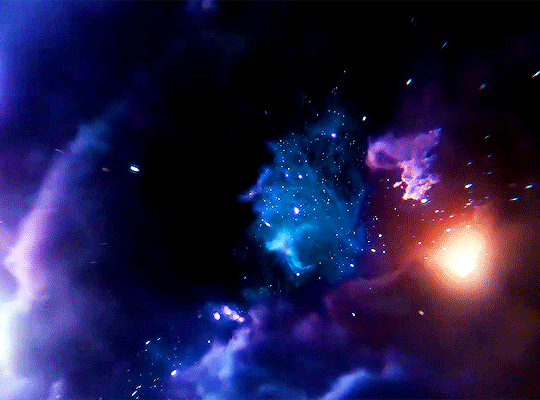

Nkisi Sarabanda, symbolizing the signature of the spirit, is a representation of a bakongo cosmogram. This symbol portrays how the Congo-angolan people viewed the interaction between the spiritual and material world, or in other words between the living and the dead;the Congo-angolan people believe that these worlds are inherently intertwined. An Nkisi is a spiritual object used for worship purposes, and have been found in places where enslaved Africans have lived in, such as in the plantation homes. Nkisis show the development of African American culture in how they are essentially African objects, but are constructed through American materials. This also reveals an aspect of the melting pot of African and American culture. Sarabanda just connotes "the highest spirit". Part of the symbol takes the form of a cross, because the Congolese had an inclination towards Christianity. Communication appears to take place at the center of the cross, where the worlds intersect, and it was believed that spirits sat at the center of the sign. The arrows represent the four winds of the universe, and the symbol as a whole resembles the form of a spiral galaxy;this indicates their interest in astronomy and affinity towards nature.

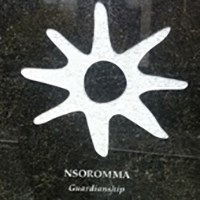
Nsoromma, meaning "children of the heavens" or "star," symbolizes the guardianship of God and how he watches over all beings. It is one of the many Adinkra symbols that the Ghanaian people have lived by. The protection of God is constant, like the stars in the universe. The stars also embody light, with the vision of light slicing through darkness as a savior, or protector. The symbol indicates the existence of the spiritual world, in which our ancestors and past families exist and watch over us, creating a feeling of safety and wholeness. Nsoromma expresses the message to live life to its fullest knowing that you are supported and strengthened by God.


Divinity of Mother Earth
Asase Ye Duru—literally meaning “the earth has no weight”—is a symbol that represents power, providence and divinity. The symbol is one of many adinkras, or depictions of important concepts created by the Akan peoples of Ghana. Asase Ye Duru emphasizes the importance of the Earth and its preservation. People must respect and nurture the Earth, and should never act in ways that might directly or indirectly harm the Earth. The significance of the Earth to the people of Ghana is evident in the following proverbs: Tumi nyina ne asase, meaning All power emanates from the earth; and Asase ye duru sen epo, meaning The earth is heavier than the sea. The African Burial Ground honors these principles, as it surrounds itself with natural resources and emphasizes the cohesion of death and nature.

#vodun#african traditional religions#panafrican thought#kemetic dreams#asase#duru#akan#earth#ghana#nso#nsoromma#children of the heavens#nkisi#nkisi sarabanda#bakongo#bakongo symbolism#gye#gye nyame#legba#new orleans voodoo#haitian vodou#brazil#trinidad#cuba#denise alvarado#obeah#kabbalistic#odinani#horus#set
151 notes
·
View notes
Text
New Orleans Voodoo Community Blessing.
😄 Yes, this is the 90's
#Voodoo Blessing#Community Voodoo#new orleans voodoo#spiritual#like and/or reblog!#follow my blog#Southern Voodoo#Spiritual blessing#Voodoo possession#african diasporica#african spirituality
9 notes
·
View notes
Text
Love and Sorcery: The Fate of Matilda Hailstork, Conjure Woman

Imagine getting sentenced three years in prison for practicing conjure like we do today because one of your clients is upset and takes you to court because a fixed candle they bought from you did not work. Matilda Hailstork's story from 1895 describes just such a scenario, only she fixed a dress, not a candle. This was the period in time when the terms Voudou and Hoodoo began to be used interchangeably and when practitioners began going underground. The public ceremonies and community rituals were rapidly disappearing.
Matilda Hailstork, a practitioner of "charms," "spells," and "hoodoo" medicine, was convicted of obtaining money by false representation and sentenced to three years in the penitentiary. One victim, Agnes Sheppard, testified that Matilda took a purple dress and fixed it to attract a man to Agnes, but the desired result did not occur. Matilda was acquitted on one charge but faced additional accusations, including obtaining items and money from other individuals, leading to her conviction on multiple counts.
To learn more about the famous, infamous, and obscure ancestors of Hoodoo, New Orleans Voudou, and conjure, check out the course Who's Who in Hoodoo History. https://www.crossroadsuniversity.com/courses/who-s-who-in-hoodoo-history
#hoodoo#rootwork#creolemoon#conjure#neworleansvoodoo#authordenisealvarado#crossroadsuniversity#new orleans voodoo#matildahailstork
47 notes
·
View notes
Text





Representation of Haitian Voodoo in comics. Integrating its rich mythology and its deities.
Art by: vodou.renaissance
#witches#witchcraft#witch#baby witch#witch community#magick#pop magick#pop culture magic#pop culture magick#louisiana hoodoo#hoodoo witch#new orleans hoodoo#hoodoo#folk magic#african folk magick#folklore#creole voodoo#new orleans voodoo#louisiana voodoo#voodoo#comics#comic#comic art#pop culture
7 notes
·
View notes
Text



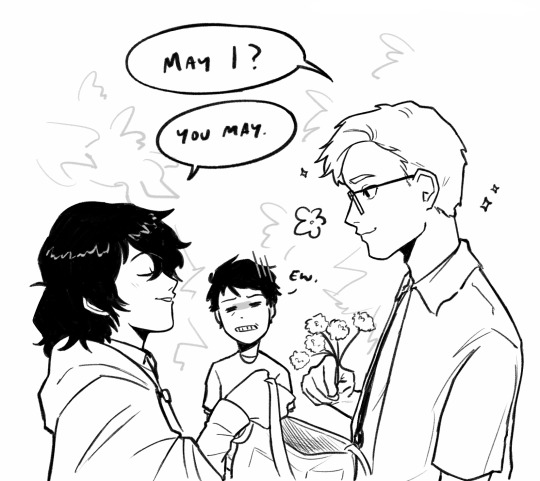
percy is not being a team player rn
#pjo#percy jackson#nico di angelo#jason grace#jasico#….? i think#drawing#this is like. maybe almost nonsensical but it’s an au in new orleans & hazel and nico practice voodoo#aletheia au
685 notes
·
View notes